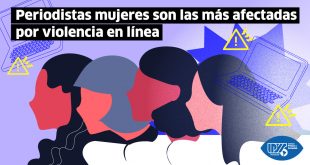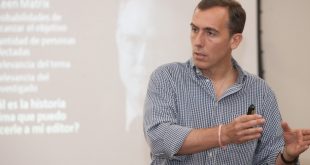Translated by Luisa Vargas Meyer
Editor’s Note: The following Investigative report by journalist Laura Weffer Cifuentes started circulating through a tweet she sent out on March 17, 2014 at 18:53. She took this action after Eleazar Diaz Rangel, director of the Venezuelan newspaper Ultimas Noticias, censored it. Later that same day, the Chief Investigator at the newspaper, Tamoa Calzadilla, resigned her position quoting fellow journalist Nathaly Alvaray on her twitter feed: “Journalism First”. Alvaray was media vice-president at the same company, Cadena Capriles, until March 7th, when she resigned under pressure from the new editor David de Lima, a lawyer with ties to the government of Maduro. What follows is a direct translation of the text which has by now circulated widely among venezuleans.
Protests / The governments insist that they are financed by a political organization, but this is denied by those who take part in the barricades. What’s Behind The “Guarimbas”? Altamira Square is the epicenter of the clashes in Caracas. Protesters and the Bolivarian National Guard (GNB) collide every day to exhaustion.
The average age of the protestors is between 19 and 22 years of age; they wear hoodies and insist that their fight is for Venezuela
The average age of the soldiers of the National Guard is between 19 and 22 years of age; they a uniform and insist that their fight is for Venezuela.
They have been fighting each other with rocks and tear gas in Caracas since February 12, but in their backpacks they carry stories that have a parallel that goes beyond the trenches.
A day at Altamira Square reveals that the protesters create protection networks; that they belong to the working and middle class; they also come from the interior of the country, and there are also the homeless that show up for the free food. The trigger of the day is usually when protesters shout: “Let’s go to the highway!” They are talking about the Francisco Fajardo Highway.
The Preparation. The activity in Altamira Square begins after ten in the morning. From the early hours those who live there cover their faces. They don’t like photographs because they fear imprisonment by the government forces. “These past days they took my partner. We were looking out for each other when things began to get ugly down there”. He is referring to Altamira Sur, the main stage of the confrontations. Jose is from Barquisimeto (25). “I’ve been here since the 15th for my son. He is one year old and I can’t find diapers or milk”. He lives out of the kindness of the neighbors. Since he arrived he has been sleeping in Los Ruices, Palo Verde, and Caricuao. His friends abroad write to him: “Wow! How cool for you to be there!” He comments: “I do believe we are writing a new history”.
On March 11th, eleven people were detained during a raid in the parking lot of the square. Before that, more than 150 had been detained in different operations.
The young people insist that the guards and police officers live at the office building Torre Britanica. On March 12, groups of vandals plundered six government offices located there.
On Sunday they burned down a Metrobus booth.
“Days? I haven’t been home in weeks! We have been quartered here since this situation began”, says an officer that does not offer his name. He takes the time to explain that his role is to enforce the free passage and cites article 50 of the Constitution, which refers to this right. He insists that this is the last place he would like to be at. “We don’t enjoy detaining the protesters. But this is what we have to do. We are within the law”.
The placards displayed by the protesters also refer to the Constitution (Art. 68): “The citizens have the right to protest peacefully and without weapons”. Until they throw the first rock.
External Solidarity. It is noon and the points of access to Avenues Luis Roche and San Juan Bosco have been blocked. In the first avenue, the protesters place a car in the middle of the street. On one side they burn a tire near some “miguelitos” (a rope pierced with nails). On the other side there is a crack wide enough for a motorcycle to pass through. Several attempt to go through, but Ronald prevents it by lying down on the asphalt. He is 17 years old and he joined the protests since day one. “I want my mother to know that I have more probabilities of graduating than of being killed”. He admits that he does not belong to the opposition nor to the chavismo: “I’m a Venezuelan”, he says behind a mask similar to the ones used by body shop painters. A driver approaches the barricade. They don’t let him go through. He shouts insults in retribution.
Someone arrives with bags of food and medicines. There is a distribution logistic. Suddenly the youngsters begin clapping. A truck stops right in front of the barricade and they unload several bags filled with dried leaves.
The Secretary of the Interior, Miguel Rodriguez Torres denounced that some of the protesters detained in Altamira admitted having received Bs. 5,000 a week from the Voluntad Popular political party. “Don’t you think that if that was true I would have already purchased an anti-tear gas mask?” asks Jose (23) with a Maalox covered face (the antacid is very effective in neutralizing the effect of tear gas). He pulls out his wallet. He has three Bs. 5.00 bills: “This is my capital”.
The average salary of the GNB troops is Bs. 6,000 a month, plus food stamps. They work three weeks on and one off, but the budget is not enough to visit their family in the interior of the country. Their accents give them away. They come from Maracaibo, Sucre and Aragua.
Activated. The moment of truth. At 2:50 pm there is a shout that is repeated in echo. “Let’s get activated!” There is a group by a water fountain practicing the throwing and catching of tear gas canisters. They train with a ball. They cover their arms with shields made of pieces of tin, with the acronym in blue: “GRIE” (Immediate Response Elite Guarimberos, by their initials in Spanish). They come haphazardly. Youngsters wearing ski masks, Guy Fawkes (known as Anonymous) masks, and people dressed for work, and students. Those who carry their Maalox spray bottles place themselves beside the “fronters”, in the line of fire.
There is a routine. Like in a rehearsal, the protesters take the first step and throw rocks and homemade bombs to open the way towards the highway. Some days the military try to dissuade them with words; other days they rush the ending, which is always the same. A deluge of tear gas which turns into a toxic fog that hinders breathing; it burns the eyes and the skin. Some faint. The first ones in the line of fire put into practice their training. They kick the tear gas canisters. When the protesters show weakness, the military push on. Hours go by.
Darkness. Every night the protesters move their protests to Ave. San Ignacio de Loyola in Chacao. Sometimes the GNB acts, and sometimes it doesn’t. At 6:00 p.m. they place sofas, mattresses and even old refrigerators. The Head of the Government of the Capital District, Jacqueline Faria, said that since F-12 there has been a decrease in the amount of trash that arrives at La Bonanza landfill.
“I live in 23 de Enero and it is true that the ‘colectivos’ go by threatening us with their loudspeakers. But if I had 30 kids to go to battle with, I wouldn’t doubt it”, says Lis (19).
Every night there are at least four small tanks with eight barrels on top, which shoot tear gas canisters. There are also troops with shotguns. Over the detonations you can hear the profanities and loud “sons of bitches!” that come out of the windows. They throw bottles and rocks. They respond with more tear gas and pellets. Sometimes straight into the apartments. Other times, the small tanks crush parked vehicles. One of “olive greens” remarks that his partner lost his hearing in one ear due to a “tumbarrancho” (an explosive firework).
From the water cannon truck (called “the whale”) you can hear Chavez’s voice sing “Patria Querida” (Dear Motherland). The men in uniform explain that it is meant to “boost the morale of the troops”, and it does not mean they are taking sides. Before midnight the calm returns. A young national guardsman says: “My mother, from Zulia, has to withstand the same lines these kids have to in order to buy a bottle of oil. I believe they are right, but sometimes they go too far”. He adjusts his bullet-proof vest. Tomorrow will be another day.
Behind the mask
The student: is between 17 (sometimes younger) and 25 years old. Athletic. Uses a ski mask, T-shirts tied around the head or masks. Is asking for changes in government. Alleges that they are in the street looking for a better future. Comes from every area of the city (and the country). Social strata: working class and middle class. Women are very active, but men are even more so.
The “guarimbero”: Provokes the people to take over the highway. Dresses similarly to the students, although they are older. They like the color black and are in favor of radicalizing the protests. The anticommunist speech is rooted in them and they advocate for a quick ending. Does not debate, gives orders and goes into action. Denigrates those who do not accompany him, whatever their tendency.
The groupie: Considers Altamira Square as a place to meet people. Before the confrontations took selfies with a multitude in the background, as if they were participating; but in truth when the heat turns up, runs. In general, rides a motorcycle. There is also the onlooker; people in suits or in working clothes that walk across the square or sit on the sidewalks just watching.
The companion: Almost always a woman. Mother of the teenager who allows her child to participate, but is too nervous to stay at home. She then accompanies her child and chants slogans. Carries placards. There is also the woman who protests because the situation in the country has made her children leave the country. There is one who likes to be called “Terrorist Mom.”
The lookouts: “Don’t take pictures” and “Show me your card” are some of the phrases they use. They see possible snitches and find infiltrators where there is none. Although they have found some that work for police intelligence, there are journalists and citizens who have been victims of their false accusations.
More barricades in Caracas
In Caracas there are trenches of this type, not only in Chacao and Altamira, but in other areas such as Macaracuay, La Boyera, El Cafetal, Candelaria, Manzanares, and Colinas de Bello Monte. The Baruta Police patrols the avenues to clear the way, but after 5 pm the neighbors of the area install the barricades once more. The “guarimbas” were cause for verbal confrontations among members of the community. Although some support the protests, they are opposed to blocking the streets. Manuel da Silva, owner of a liquor store in Bello Monte insists on being “worn-out” and reveals that his sales have dropped between 60 and 70 percent. (Blanca Gonzalez.)
Lethal Balance
The word “guarimba” does not exist in the dictionary, but in Venezuela it is commonly used. The political activist Robert Alonso, tied to the case of the presumed paramilitaries (2004), claims credit for it. He describes it as “blocking of streets in front of homes” with waste, trash, or tires. As of today and since February 12th, seventeen individuals have died in events related to “guarimbas”. Seven died because their vehicle lost control due to a barricade and the other nine were murdered while they tried to build one or were close to one. The government has singled out alleged sharpshooters. In another case they held the “guarimba” responsible for preventing the timely arrival of an ambulance. These deaths are part of the 28 that have occurred since the beginning of the protests. The rest were caused by government security forces or unidentified shooters on motorcycles.
Valencia Trenches
In the past month the number of protesters in Ave. Rio Orinoco in Valencia has been increasing. With the passage of days the neighbors strengthened their barricades. The boldest ones allow their children to go with them. The radical ones take the opportunity to narrate their epic battles. The block coordinators control the logistics and the supplies. The women are devoted to feeding the members of the cell in a communal kitchen. The lookouts take their job seriously; they loaf about only when they are dismissed. “He who gets tired loses”, reads a placard. (Gustavo Rodriguez.)
Margariteños amid junk
Julián is in charge of the supply storeroom of a “guarimba” in Margarita. He tells that they receive donations from the civil society. “We do not receive anything from the political parties”. A student explained that between 40 and 45 people set up the barricades. Dayana said that most of the junk is found in the dumpsters from buildings and communities. “The Barricades are a way of protecting ourselves from the ‘colectivos’, because we protest peacefully”, a student comments. When they are reminded of the rights of others, they sustain that the situation in the country affects everyone. Sascha Moncada.
As per request of the interviewed parties, their names have been changed for safety concerns.
Via Prensa CNP Caracas
 IPYS Instituto Prensa y Sociedad Venezuela
IPYS Instituto Prensa y Sociedad Venezuela



